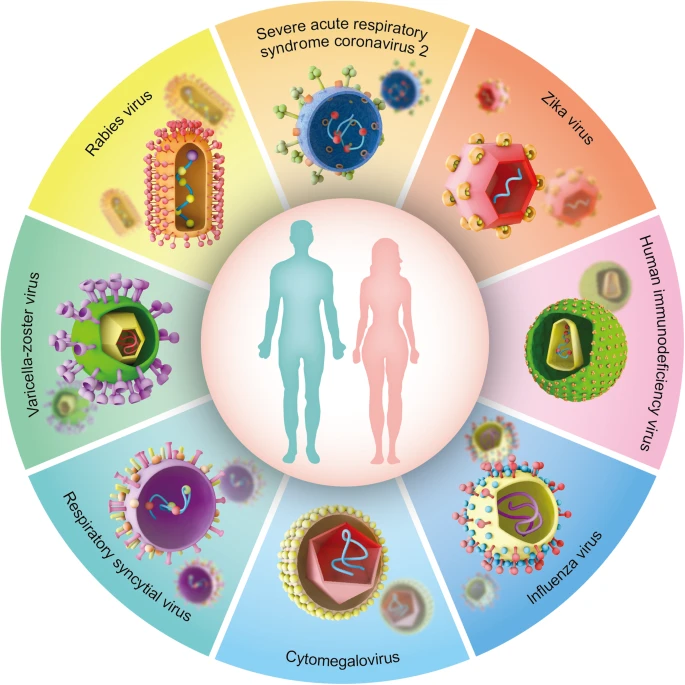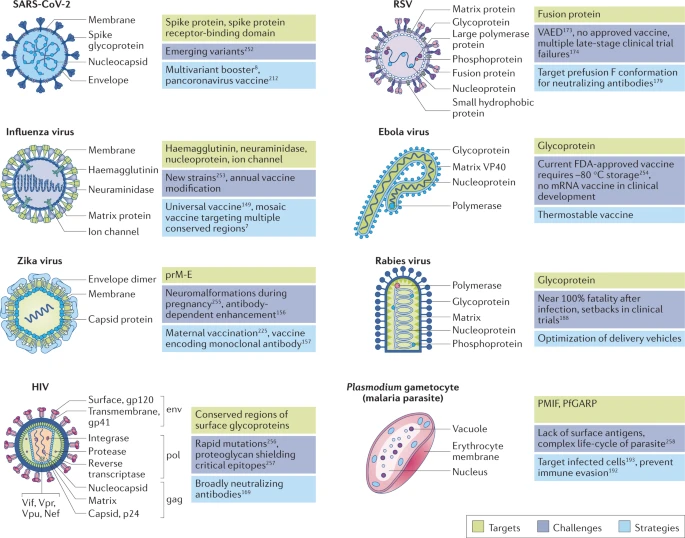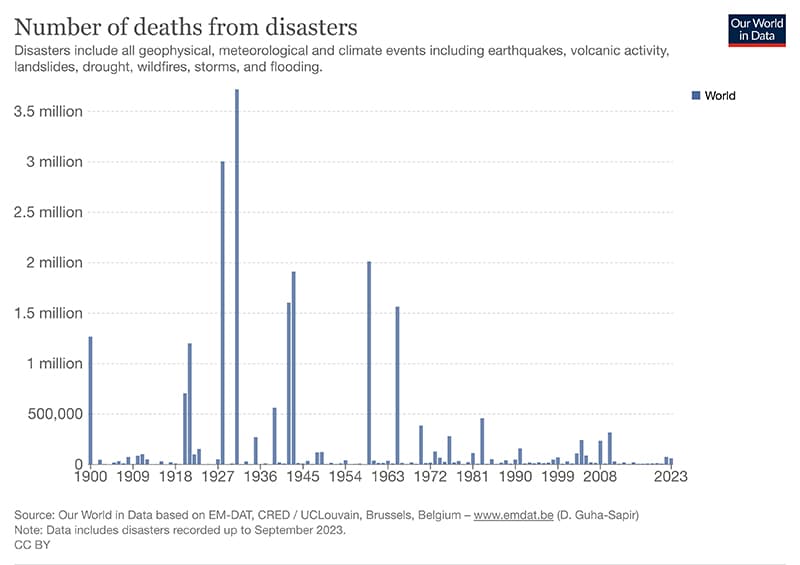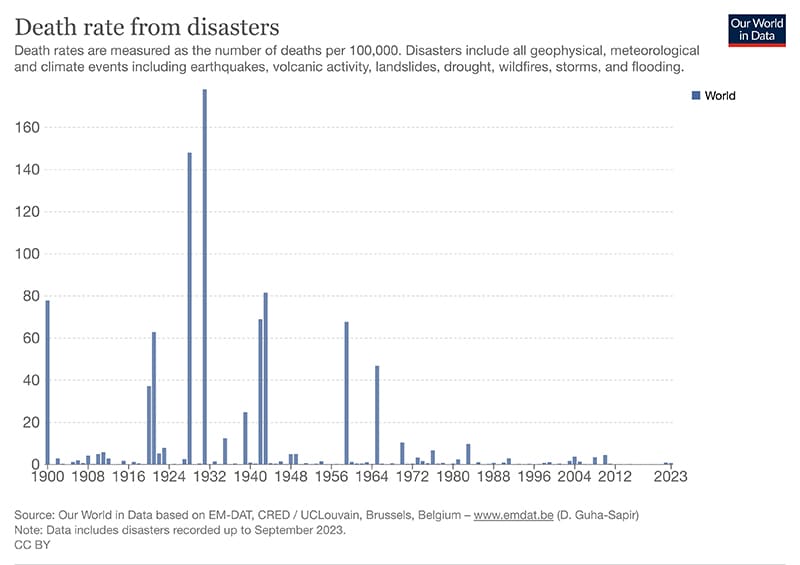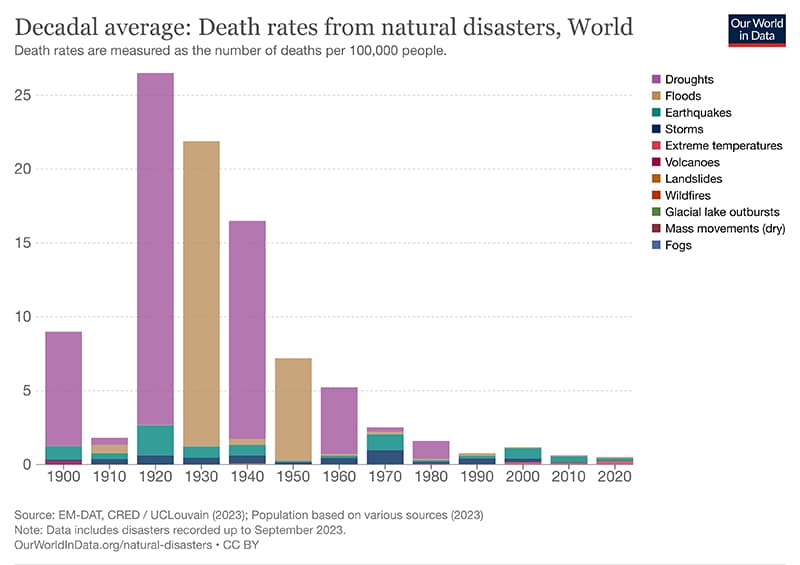
Châtenay-Malabry (FR - 92290), October 16, 2023
EFITA newsletter / 1080 - European Federation for Information Technology
in Agriculture, Food and the Environment
The informatique-agricole.org site offers you the possibility of subscribing
the RSS feeds of its two newsletters
See RSS feeds
to implement to ensure that you continue to receive this newsletter
To unsubscribe
this newsletter, please contact me directely: guy.waksman(a)laposte.net
if this
link Unsubscribe does not work.

To correspond with me (GW), please use this address: guy.waksman(a)laposte.net
To subscribe the efita newsletter (please ask your friends and colleagues
to test this link)
Efita
Newsletters subscription
Before computers / Mowing wheat
|
16/10/2023
|
 |
|
Weekly newsletters about ICT in Agriculture in English and French
Both newsletters have around 5000 subscribers.
>>> Last weekly EFITA Newsletters in English (created in 1999)
Efita
Newsletters
>>> Last weekly AFIA Newsletters in French (created more than
20 years ago in 1997) Afia
Newsletters
>>> Statistics
for the latest efita newsletter
>>> Latest
issue of the afia newsletter
>>> Latest
available satistics for the afia newsletter
More details emerge on Kuhn’s autonomous field robot, Karl
French agricultural machinery manufacturer Kuhn has provided additional
insights into its upcoming autonomous field robot, Karl, following a leak
of images via French media.
Karl, a multifunctional field robot designed for open-field cultivation,
was initially announced by Kuhn in July during a press conference at the
company’s headquarters in Saverne, where few details were revealed.
.../...
During the initial announcement in July, Kuhn CEO Thierry Krier emphasized
the significance of consolidating multiple operations into a single pass,
highlighting it as the future of agricultural machinery. He also acknowledged
the need for lighter equipment to enhance soil quality, recognizing the
prevalent challenges posed by labor shortages in the farming sector. Krier
clarified that Karl is not merely an autonomous tractor but a comprehensive
solution designed for the European market. “The current version is complete,”
he stated, reinforcing Kuhn’s commitment to providing innovative equipment
solutions for modern agriculture.
Debunking generative AI myths for grocers, Oct. 10, 2023, By Bobby
Gibbs
The fast-evolving technology is neither a passing fad nor a silver bullet,
writes Bobby Gibbs with Oliver Wyman. Here’s how grocers should approach
it.
.../...
>>> A tool, not a solution
Even while GenAI has so many viable use cases in the market today, it
is just one of the tools that the food industry should be using to improve
business performance. Personalization will greatly benefit from integrating
GenAI.
At the same time, numerous integrations are necessary to create an end-to-end
personalized experience. GenAI is not a replacement for the machine learning
algorithms that identify the best merchandising offers for an individual
customer. Likewise, there is too much eagerness to apply GenAI to supply
chain challenges when in fact what is needed is more accurate forecasting,
better product visibility and routing optimization. GenAI solutions may
support more efficient development of analytical solutions but are not
a replacement for the hard work of data source identification and cleaning,
model selection, and parameterization and tuning.
Still, there are so many reasons to be bullish on the applicability of
GenAI. There is an undeniable level of excitement at its potential and
new capabilities continue to roll out month after month.
The best time to begin developing GenAI solutions may have been January
of this year. The next best time to begin is right now.
See
grocerydive.com
10 years on from Climate Corp’s $1bn acquisition, David Friedberg reflects,
October 2, 2023, by Louisa Burwood-Taylor
Ten years ago today, Monsanto announced that it was purchasing the Climate
Corporation, a company using “machine learning to predict the weather
and other essential elements for agribusiness,” for $1 billion.
I started reporting on the agriculture industry just after this deal happened
and remember the excitement that continued for months if not years in
its wake. It was also argued that it played a role in driving Bayer’s
subsequent acquisition of Monsanto for $63 billion in 2018.
In fact, you could argue that much of the excitement for the agrifoodtech
industry at large is down to this deal that put a spotlight on the opportunity
— and potential — for agtech to make entrepreneurs and investors money.
Investment in agtech increased exponentially in the years after and soon
the industry was raising tens of billions of dollars a year (albeit with
a dip here and there!)
But how did it come about? How did founder and CEO David Friedberg reach
that valuation, which has proven pretty much elusive to our industry ever
since? How has our industry changed in its aftermath? And what’s coming
next for agrifoodtech?
.../...
It doesn’t mean the companies are valueless; it doesn’t mean that there
isn’t something good there. It just means that the value now with all
public companies, public biotech and growth stocks is worth less than
the cash that’s gone in. And so there’s a real kind of reset that’s happening
right now.
See
agfundernews.com
« Dimanche de lecture dans une école rurale », 1895, par Nikolay Bogdanov-Belsky
(1868-1945), Musée Russe, Saint-Pétersbourg
|
01
- 16/10/2023
|
 |
|
« Au seuil de la classe », 1897, par Nikolay Bogdanov-Belsky (1868-1945),
Musée Russe, Saint-Pétersbourg
|
02
- 16/10/2023
|
 |
|
Machine learning: Meet the startup harnessing AI to optimize cell culture
media formulation , 1, October 10, 2023, by Elaine Watson
What’s the key to cutting the cost of cell culture media for cultivated
meat?
Finding more efficient ways to produce pricey inputs such as growth factors
(proteins that encourage cells to grow and differentiate) at scale will
be critical, whether that’s via genetically engineered microbes, plants,
or fruit flies. But that’s only part of the challenge, says London-based
startup Multus Biotechnology.
“What holds back media development is the inefficiency of optimization,
so that’s across cost; ingredient quality, potency, stability and sustainability;
scalability; and bioprocess productivity [proliferation rate, cell density,
differentiation efficiency etc],” Multus Bio head of business development
Dr. Charlie Taylor tells AgFunderNews.
“Optimizing across objectives across all of these areas at the same time
is the real challenge facing companies in this space. It’s not just a
case of how do we make growth factors cheaper?”
See
agfundernews.com
Aussie agtech startups shaping the future of carbon capture, October
9, 2023
Australian startups are working hard to change the way we monitor, manage
and report soil carbon sequestration to provide the world with more effective
tools in the fight against climate change.
With an ambitious goal to cut carbon emissions by 43% by 2030 and achieve
net zero by 2050, Australia is moving aggressively to accelerate carbon
capture and storage solutions.
AgriFutures growAG., a free online platform connecting Australian agrifood
research, innovation and commercial opportunities with the global market,
is championing this goal by spotlighting ground-breaking technologies.
Among the trailblazing startups leading the charge in carbon capture solutions
for farmers are soil carbon project developer AgriProve; pasture optimization
and carbon startup Agrimix; and environmental measurement software and
soil sampling service FarmLab.
Each of these startups have listed opportunities on AgriFutures growAG.,
including investment rounds and strategic partnerships to tackle the challenges
of monitoring, reporting and verification (MRV), referred to as “a cornerstone
of carbon markets” by the World Bank.
See
agfundernews.com
Entre deux leçons. 1913, par Nikolay Bogdanov-Belsky (1868-1945), Musée
d'État de Novossibirsk
|
03
- 16/10/2023
|
 |
|
Rantizo raises $6m series A expansion for spray drone services; enjoys
‘exponential growth’, October 2, 2023, by Elaine Watson
- Spray drone services provider Rantizo has raised a $6 million expansion
of its series A round (adding to the $7.5 million announced in 2020) led
by Leaps by Bayer, and supported by Fulcrum Global Capital and Innova
Memphis.
- The capital injection will help the Iowa-based company expand its nationwide
operator network, which now works across 30 states with more than 20%
of the nation’s top 50 ag retailers.
…/…
See
agfundernews.com
Farm robotics startups face a talent shortage. Academia and tech are
working together to change that, by Jennifer Marston
Startups have made strides in the last few years turning the theoretical
benefits of ag robotics and automation into actual realities for farmers.
But there’s still a ton of work to be done when it comes to making tools
that are complex enough for smart spraying and laser weeding, but don’t
also require a PhD to operate.
Ergo, startups will have a lot of new hires to make in the coming years,
many of them from the growing pool of talent coming out of college, said
many at the FIRA USA 2023 farm robotics show in Salinas, California.
Enter the annual Farm Robotics Challenge organized by the AI Institute
for Next Gen Food Systems (AIFS), University of California Agriculture
and Natural Resources (UC ANR) initiative the VINE, the Fresno-Merced
Future of Food (F3) coalition, and robotics company farm-ng.
The three-month-long challenge aims to give students hands-on experience
developing practical applications for farm robotics while also training
up the next wave of talent for the agtech industry to hire.
.../...
See
agfundernews.com
The Week in AgriFoodTech: Paine Schwartz launches $1.7bn agrifood fund,
Cricket One's new plant, Infarm declared bankrupt, by Jennifer Marston
Panelists in an early session at this week’s World Agri-Tech Innovation
Summit in London spent the better part of their discussion discussing
the whats, whys, and hows of agtech tools: What tools will we need to
produce food now and in the future, why we need them and how we’ll use
them.
“But we’ve missed one,” Diana Lenzi, president of CEJA, the European council
for young farmers, told attendees. The who.
Who is going to be using these tools in the first place?
The farmer, of course, is the answer, but too often, agtech tools and
services are, as the saying goes, solutions in search of problems. Or
as a recent McKinsey study put it, more farmers would adopt agtech “if
their concerns are addressed.”
Lenzi noted that there are a lot of solutions out there, but the industry
needs to ensure they’re the right ones for the field and the farmer. The
following are a few pieces of advice she gave the panel on how to achieve
that:
.../...
See
agfundernews.com
Au travail, 1921,
par Nikolay Bogdanov-Belsky (1868-1945)
|
04
- 16/10/2023
|
 |
|
« Calcul mental à l'école populaire de S. A. Ratchinski », 1895, par
Nikolay Bogdanov-Belsky (1868-1945), Galerie Tretiakov, Moscou
|
05
- 16/10/2023
|
 |
|
mRNA vaccines pioneers win Nobel
The Nobel Prize in Physiology or Medicine has been awarded to biochemist
Katalin Karikó and immunologist Drew Weissman for discoveries that enabled
the development of messenger RNA (mRNA) vaccines against COVID-19. The
vaccines have been administered more than 13 billion times, saved millions
of lives and prevented severe illness in millions of people. Karikó and
Weissman discovered a way to deliver mRNA into cells without triggering
an unwanted immune response: by swapping one type of molecule, uridine,
in the genetic material with a similar one called pseudouridine.
In 2021, in this newsletter, Nature Chief Magazine Editor Helen Pearson
recommended a profile of Karikó in The New York Times. “First for showing
how the spectacularly fast production of COVID-19 vaccines actually rests
on decades of meticulous basic research into mRNA, and second for highlighting
the difficulty that many scientists face when moving precariously from
one temporary position to another to pursue the bench research they love.”
Later that year, Karikó and Weissman won one of the most lucrative awards
in science: the US$3-million Breakthrough Prize. Karikó recalled the scepticism
surrounding her work in the 1990s that led to numerous grant-proposal
and paper rejections (including the 2005 paper for which she is now being
recognized), and forced her to take a demotion and a pay cut.
…/…
See nature.com
‘We are just getting started’: the plastic-eating bacteria that could
change the world, by Stephen Buranyi, The Guardian, September, 28 2023
When a microbe was found munching on a plastic bottle in a rubbish dump,
it promised a recycling revolution. Now scientists are attempting to turbocharge
those powers in a bid to solve our waste crisis. But will it work?
In 2001, a group of Japanese scientists made a startling discovery at
a rubbish dump. In trenches packed with dirt and waste, they found a slimy
film of bacteria that had been happily chewing through plastic bottles,
toys and other bric-a-brac. As they broke down the trash, the bacteria
harvested the carbon in the plastic for energy, which they used to grow,
move and divide into even more plastic-hungry bacteria. Even if not in
quite the hand-to-mouth-to-stomach way we normally understand it, the
bacteria were eating the plastic.
The scientists were led by Kohei Oda, a professor at the Kyoto Institute
of Technology. His team was looking for substances that could soften synthetic
fabrics, such as polyester, which is made from the same kind of plastic
used in most beverage bottles. Oda is a microbiologist, and he believes
that whatever scientific problem one faces, microbes have probably already
worked out a solution. “I say to people, watch this part of nature very
carefully. It often has very good ideas,” Oda told me recently.
.../...
Like a rare and exotic animal that cannot thrive in captivity, most micro-organisms
didn’t seem suited for life in the lab. And so scientists were stuck with
whatever could survive in their limited conditions. Yet there were some
microbiologists who attempted to escape this straitjacket and discover
the true extent of the microbial kingdom. The story of the discovery of
penicillin by Alexander Fleming in 1928 is familiar: a fungal spore wafting
through the corridors of St Mary’s hospital and settling at random in
Fleming’s petri dish contained penicillin, which turned out to be one
of the most potent medical weapons of the 20th century. Less well known,
but no less significant, is the story of the Rutgers University chemist
Selman Waksman, who coined the term “antibiotic” after noting that certain
soil bacteria produced toxins that killed or inhibited other bacteria
with whom they were competing for food. Waksman worked tirelessly to figure
out the conditions required to grow these wild bacteria in his lab, and
his efforts produced not just the second commercially available antibiotic,
streptomycin, in 1946, but the next five antibiotics brought to market,
too. Ultimately, searching the soil for antibiotic-producing microbes
proved far more fruitful than waiting for them to float into one’s laboratory.
Today, 90% of all antibiotics are descended from the grouping of bacteria
that yielded Waksmans original discoveries.
Efforts like Waksman’s were relatively rare. It wasn’t until the discovery
of simple chemical techniques to read the sequence of DNA – first emerging
in the 1970s, but widely and commercially available from the mid-1980s
– that things began to change. Suddenly the microbes under the microscope
could be catalogued and identified by their DNA, which also hinted at
how they might grow and function. Not only that, says Handelsman, “the
genetic diversity we were seeing was enormous”. It turned out that “these
life forms that looked quite similar are in fact very, very different.
It opened this door to realising how much more was out there.”
.../...
The vision of a deeper partnership with microbes is a powerful one. The
EU has funded several groups to develop microbes and enzymes to turn plastic
into fully biodegradable materials, rather than just new plastic. Last
year, a German group engineered the Ideonella sakaiensis PETase into a
marine algae, noting that someday it could be used to break down microplastic
in the ocean.
Oda is convinced we haven’t even scratched the surface. When he and his
colleagues first found Ideonella at the dump nearly 20 years ago, it wasn’t
working solo. “As soon as I saw the film of micro-organisms on the plastic,
I knew it was many microbes working together,” Oda told me. His team realised
that while Ideonella was breaking the plastic into its industrially valuable
precursors, other microbes were stepping in to further chew those into
simple nutrients the microbial community could use. They were symbiotic.
Partners, in a way. Oda has since written several papers pointing out
that microbial communities might be developed into a system to remove
micro- and nanoplastics from the soil. But he has received little interest.
In our conversations, Oda repeatedly bemoaned the lack of truly world-changing
ideas coming from people who wanted to commercialise the discoveries he
and his colleagues had made. There was an incredible amount of excitement
about a factory that could turn old plastic into new; far less, it seemed,
about one that could turn plastic back into water and air.
See theguardian.com/
Maybe volcanoes doomed the dinosaurs
A machine-learning algorithm suggests that volcanic activity, rather than
an asteroid, killed the dinosaurs. The algorithm simulated 300,000 scenarios
of different amounts of volcanic gases until it found one that matched
data from fossils. The gases would have started to cause dinosaur-dooming
climate chaos long before the asteroid impact.
“You can actually recreate the environmental conditions that could cause
a dinosaur extinction solely by volcanism, as if the asteroid weren’t
there,” says computational geologist and study co-author Alexander Cox.
“But of course, we can't discount the fact that the asteroid definitely
didn't cheer up the dinosaurs.”
See wired.com
‘For the Culture’ Is a Joyful Celebration of Black Women and Femmes
in Food, by Nancy Matsumoto - September 28, 2023
Klancy Miller’s new book, For the Culture: Phenomenal Black Women and
Femmes in Food, features 66 interviews with Black women in food, wine,
and hospitality and 48 recipes collected from her subjects, plus vibrant
illustrations by Sarah Madden and lavish photography by Kelly Marshall.
Though the book is a joyful celebration of Black women and non-binary
femmes and their achievements, it does not shy away from addressing hard
truths about racism, money, and mental health.
In the book, Miller pays homage to the grandes dames of African American
culinary history, from cooks and authors Edna Lewis and B. Smith to culinary
anthropologist Vertamae Smart-Grosvenor. She also pays tribute to “all
the Black women and femmes who steward the land, feed us, and bring us
together with food and wine,” including farmer Leah Penniman, chef Mashama
Bailey, culinary historian Jessica B. Harris, and television host and
producer Sophia Roe.
Miller hopes this book will provide the kind of information, advice, and
“sisterly insights” she wishes she’d had access to as she was coming into
the world of food and food media.
See civileats.com
mRNA vaccines for infectious diseases: principles, delivery and clinical
translation, by Namit Chaudhary, Drew Weissman & Kathryn A. Whitehead,
Nature
>>> Clinical trials for mRNA vaccines in infectious diseases
Berger Proshka, par Nikolay Bogdanov-Belsky (1868-1945)
|
06
- 16/10/2023
|
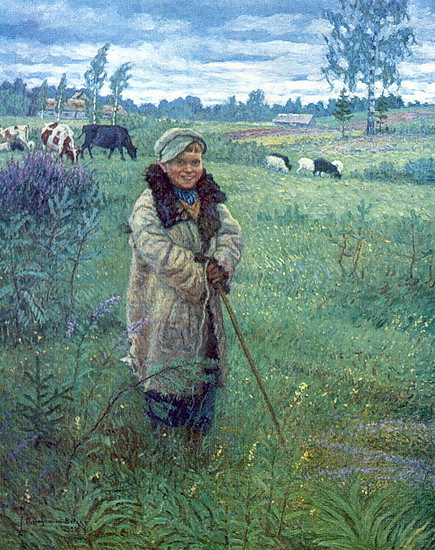 |
|
Food companies aren’t all walking the talk on regenerative agriculture,
says FAIRR investor network, by Elaine Watson
There’s a lot of talk, but rather less action on regenerative agriculture
from some publicly listed agrifood companies, according to a new report
from investor network FAIRR.
Two thirds of publicly-listed agrifood companies that have talked publicly
about the potential of regenerative agriculture “have not put in place
any formal quantitative company-wide targets to achieve those ambitions,”
according to FAIRR.
There is no universally accepted definition of regenerative agriculture,
but initiatives typically focus on carbon removal or sequestration, soil
health (soil organic matter, water-holding capacity, micro/macronutrients),
biodiversity, watershed health (more efficient use of water and reducing
pollution), and farmer livelihoods.
.../...
See
agfundernews.com
3 agtech startups bringing financial inclusion to farmers in Asia Pacific,
by Louisa Burwood-Taylor
It may come as a surprise to you that the world’s agriculture industry
– the multi-trillion dollar industry that feeds us – operates on a very
informal basis in most of the world. From large-scale growers in the Global
North to smallholder subsistence farmers in the Global South, a huge amount
of business is done face-to-face with advisors and retailers who are often
personal connections.
The dawn of the internet, which rapidly pushed consumer commerce online,
had little effect on the industry in the early years, with poor rural
connectivity, financing issues, and trust concerns a few of many contributing
factors.
This has left many farmers globally lacking access to markets that could
benefit their businesses and livelihoods, including high-quality inputs
and seeds, a wide range of buyers for their produce, and finance to help
them weather the highly cyclical nature of the industry, which can often
mean just one or two paydays per year after each crop is harvested.
“Farmers bear a lot of the upfront risk in agriculture, meaning they can
potentially lose a season’s worth of income due to diseases, weather or
pests,” says Ryan Lee, associate at AgFunder and part of the selection
committee for AgFunder’s GROW accelerator program. “The inconsistency
in payment periods makes it very hard for farmers to accurately manage
their finances.”
.../...
See
agfundernews.com
Why AgFunder invested in Azaneo’s low-power electric weeding tech?
Ask any farmer about their top challenges, and they’ll almost invariably
name weeds as a major one, if not the major one.
Weeds compete with crops for space, nutrients and water in the field.
They are easily spread by wind, water and humans tromping around, and
they’re indiscriminate about where they invade — smallholder farms and
commercial agriculture settings alike face similar unending battles when
it comes to weed management.
Crop protection chemicals like glyphosate (e.g., Monsanto’s Roundup) promised
to fix this when they were introduced decades ago, but they carried an
environmental toll we’re only now beginning to fully understand.
And these days, some weeds have changed their internal biology to become
more resistant to those chemicals, further putting crop yields at risk.
For Liam Hescock, founder and CEO of Australian agtech startup Azaneo,
this resistance to herbicide was a major motivator to start the company.
“When you go out and talk with farmers, they’ll tell you we’re starting
to get species that aren’t responding to mainstream chemistry,” says Hescock,
who comes from a farming background.
Spraying, too, presents its own challenges. Spray drift — the airborne
movement of chemicals on or right after application — can reach neighboring
fields from as far as 30 kilometers away, impacting those crops.
.../...
See
agfundernews.com
Google searches for the term "Shutdown"
|
01
- 16/10/2023
|
 |
|
Many bills, no long-term effect
|
02
- 16/10/2023
|
 |
|
Septembre chaud, par Pierre Zaka
|
03
- 16/10/2023
|
 |
|
Costly shutdown
|
04
- 16/10/2023
|
 |
|
Working women
|
05
- 16/10/2023
|
 |
|
FutureFarming.com
> Variable depth cultivation: updates and new insights
Variable depth tillage comes within reach of an increasing number of implements
ánd farmers.
> Seed coating: Seed coating increases a plant’s ability to store carbon
in soil
> Soil compaction: Why do wide tires cause deeper soil compaction?
Science explains
> Nexat tool carrier: Nexat tool carrier bridges soil compaction
> Regenerative agriculture: Let nature do more work with regenerative
agriculture
> Soil compaction: ‘Super wide tires or tracks conceal a deeper danger’
> Carbon storage: CO2 storage in agricultural soils yields little climate
gain
> Soil analysis: DNA soil analysis, what’s involved and the benefits
> Carbon market: Building a carbon market – an innovative farm business
> A smart seeder that maps soil moisture and carbon
Australian company MPT has designed a smart seeder that incorporates sensors
to map essential soil properties like soil moisture and soil carbon.
> Partner feature: How auto-steering systems boost intercropping efficiency
Using AgTech in the intercropping of corn and soybeans can increase land
and fertiliser use efficiency. One of the biggest challenges facing farmers
today is increasing productivity per hectare. Intercropping, the practice
of growing two or more crops together in the same field, is being adopted
worldwide.
> Weed control: Weeding with a Laser, an observation in the field
A high-tech laser can shoot down a satellite from space. Carbon Robotics,
however, uses it for a subtler purpose - weeding.
> Warning plants : Researchers want to ‘talk’ to plants with new
tool
Imagine if humans could ‘talk’ to plants and warn them of approaching
pest attacks or extreme weather. A
> Seed round: Bonsai Robotics announced a $ 10.5 million seed
round
US company Bonsai Robotics announced a $10.5 million seed round.
> Stacked Farm to build large indoor farms in each capital city of
Australia
Stacked Farm expects its modular design of indoor farms will enable a
rapid expansion.
This month Future Farming pays special attention to indoor farming developments
> The power of precision farming
In today's rapidly evolving agricultural landscape, technology plays a
crucial role in empowering farmers to meet the challenges they face. What
makes precision farming important for future farming? Jesper Riber Nielsen,
Director, SEGES Innovation P/S, points out six main reasons.
> Fertilizer spreader: Valtra keeps fertilizer spreader automatically
horizontal
The idea of the Finnish machinery manufacturer Valtra is to automatically
maintain the horizontal position of the fertilizer spreader.
> Harvest technology: Claas tests partially electric propulsion for
Lexion combines
The German machinery manufacturer Claas is working on a hybrid propulsion
system for Lexion combines.
> Harvest technology: Case IH combine harvester looks ahead in cereal
crops
Machine manufacturer Case IH is working on new automation for combine
harvesters, in which radar sensors on the cutting platform scan the crop's
height and position.
> Harvest technology: New Fendt Butterfly Mowers adjust crimping intensity
based on prescription map
Fendt is renewing its butterfly mowers and is showcasing the Slicer 960
and 1010 at the Agritechnica trade fair.
> Lidar sensors: New Holland Large Baler controlled by Lidar sensor
New Holland is introducing new automation for large balers. The foundation
of this technology is a Lidar sensor mounted on the tractor's roof.
> Talking to plants: Researchers want to ‘talk’ to plants with new
tool
Imagine if humans could ‘talk’ to plants and warn them of approaching
pest attacks or extreme weather.
> Warning plants: Researchers want to ‘talk’ to plants with new tool
Imagine if humans could ‘talk’ to plants and warn them of approaching
pest attacks or extreme weather.
> Ploughing: Ploughing with alternative systems Huberpflug and Butterfly
Several manufacturers and inventors ventured into alternative plough systems.
> Market trends: AGCO plans to build a state-of-the-art test farm
AGCO Corporation announced plans to build a state-of-the-art test farm
in Casselton, North Dakota, USA.
> Five pioneers that are innovating agricultural and food systems
The DLG Inhouse Farming - Feed & Food Show has nominated five agri-food
pioneers for the final round of ‘Impulse Pitches: Inhouse Farming, Feed
& Food’.
> Autonomous tractors: Leek farmer tests driverless tractor; sees opportunities,
but prefers smaller tractors
Ronald Swinkels used a Massey Ferguson 7719S for a few days, which was
equipped with a fully autonomous iQuus system.
> Potato crops: How did PepsiCo´s tech tropicalize potato crops in
Brazil?
PepsiCo has been building strong partnerships with potato producers for
the last 30 years through sharing technology.
> Field robots: More details emerge on Kuhn’s autonomous field robot,
Karl
French agricultural machinery manufacturer Kuhn has provided additional
insights into its upcoming autonomous field robot.
See futurefarming.com
US continues to decarcerate
|
06
- 16/10/2023
|
 |
|
Solar panels in Shanxi 2023
|
07
- 16/10/2023
|
 |
|
Apple vs Flood Risk
|
08
- 16/10/2023
|
 |
|
Apple Footprint in Hotspots
|
09
- 16/10/2023
|
 |
|
Apple vs Energy Generation by Fuel Type
|
10
- 16/10/2023
|
 |
|
globalagtechinitiative.com
> Intelinair Revolutionizes Crop Intelligence: A Game-Changer in AgTech
Intelinair is reshaping the future of agriculture through its cutting-edge
technology.
> State of the Ag Tech Industry: Experts Share 2023 Advancements and
2024 Forecasts
Five ag tech experts explored the trends for 2023 for advancing ag tech
and what to lookout for in 2024 during our recent webinar.
> Voices of Women in Ag Tech: Ambassador Profile on Mineral's Erica
Bliss
We bring you exclusive insights from our inspirational ambassadors and
other women leading the way forward in ag tech.
> Intelinair Revolutionizes Crop Intelligence: A Game-Changer in AgTech
Intelinair is reshaping the future of agriculture through its cutting-edge
technology. By providing real-time and actionable insights into crop health,
nutrient levels, and growth patterns, Intelinair is empowering farmers
to make informed decisions and optimize their yields like never before.
> Computer Imaging For Early Detection of Greenhouse Diseases
Computer vision and AI are proving themselves as valuable tools in many
areas of CEA, particularly for the early detection of pests and diseases.
> FIRA USA 2023 Establishes Itself As the Must-Attend Event for North
American Agricultural Robotics Industry
FIRA USA, held September 19-21 in Salinas, CA, welcomed more than 1,700
participants from 40 U.S. states and 30-plus countries.
> How Satellite Communications Company Iridium Helps Manage the Flow
of Crop Inputs
Iridium’s Greg Malakoff explains how the ag community uses the company’s
network of satellites to ensure data collected is available at all times.
> Sustainable Agriculture: How Long Are We Going to Wait for Change
to Happen if We Don’t Encourage It?
As the world struggles with issues related to food security and environmental
concerns, leveraging agtech like farm management software provides optimism.
> Raven: Advancing Agriculture Through Innovation
Embark on a journey of agricultural innovation with Raven. Through cutting-edge
technology and unwavering commitment, Raven is propelling the industry
forward. Discover how Raven is reshaping farming practices and ensuring
sustainable food production for a rapidly growing world.
> BioLumic to Unlock Sustainable Global Rice Production with Light
Treatments for Seed
Groundbreaking tech supports shift to reduced water use, lowered emissions
in India’s rice cultivation.
> World Economic Forum Recognizes AgTech Company As Unicorn Startup
AgTech leader ProducePay has been invited as Unicorn Innovation Community
member to be among the world’s most promising start-ups and scale-ups.
> CEA: Pure Harvest Eyes Further Growth with Strategic Richel Group
Partnership
The partnership will deploy over $150 million worth of smart growing systems
across the Middle East and Asia.
> State of the Ag Tech Industry: Experts Share 2023 Advancements and
2024 Forecasts
Five ag tech experts explored the trends for 2023 for advancing ag tech
and what to lookout for in 2024 during our recent webinar.
> AGCO to Acquire Trimble Ag Assets and Technologies Through a Joint
Venture Focused on Next-Generation Precision Ag Technology
AGCO Corp., a worldwide manufacturer and distributor of agricultural machinery
and Precision Ag technology, announced it has entered into a Joint Venture
with Trimble, where AGCO will acquire an 85%[...]
> 5 Ways AI Technology Will Improve Agriculture in 2024
Contributing writer Reinder Prins shares five ways AI has the highest
potential to continue improving agriculture in 2024.
> AquaSpy: Maximizing Yield, Minimizing Costs in AgTech
Dive into the world of AquaSpy, where technology meets agriculture to
optimize water usage and increase yields. With innovative soil moisture
monitoring and data-driven insights, farmers can achieve maximum results
while minimizing input expenses. AquaSpy is reshaping the future of irrigation.
> Facing the Struggle Together: Supporting Farmers Affected by War
Learn how charity project FARMERHOOD is hoping to financially assist those
affected with the principle of "Farmers Helping Farmers."
> NASA, WiAT, and Tech Hub LIVE — What a Blast!
Let’s just say the stars aligned perfectly for the CropLife and NASA teams
at Tech Hub LIVE, says CropLife Editor Lara Sowinksi.
> Robotics Plus Launches Multi-Use Autonomous Vehicle for Sustainable
Orchard and Vineyard Production
Prospr automates a variety of tree crop tasks, including intelligent spraying,
to improve efficiency and alleviate labor challenges.
> Agtonomy, On-Target Collaborate to Advance All-Electric Implement
Ecosystems
The first all-electric, electrostatic smart sprayer prototype designed
for specialty crop producers makes its public debut at FIRA USA.
> AMVAC: Trending Forward in Ag Technology
Discover how AMVAC is shaping the future of agriculture with its forward-thinking
approach to technology. Through groundbreaking solutions and partnerships,
AMVAC is at the forefront of agricultural innovation. Dive into their
journey of enhancing crop protection and optimizing yield.
> Tech Hub LIVE Conference and Expo Celebrates Resounding Success in
Des Moines, Iowa
This year's conference experienced unprecedented success with over 700
in attendance - a remarkable 15% growth from the previous year.
> Multispectral Imaging in Precision Farming and Its Applications in
India
Multispectral imaging offers a data-driven approach to enhance crop health,
optimize resource use, and revolutionize Indian agriculture.
> Pitch AgriHack 2023: Unleashing Agritech Innovation in Africa
Awarding a total prize pool of USD 45,000, the competition celebrated
the brilliance of young minds that are reshaping the future of African
agriculture.
> Pyka and Dole Successfully Complete Trial Phase of Autonomous Spray
Aircraft
Dole incorporates Pelican Spray to advance smart farming and sustainability
goals.
See globalagtechinitiative.com
US People using bicycles to go to their work
|
11
- 16/10/2023
|
 |
|
Newyorkers usually biking to work
|
12
- 16/10/2023
|
 |
|
Costly Children
|
13
- 16/10/2023
|
 |
|
US High mortgage rates
|
14
- 16/10/2023
|
 |
|
Trump Property Value Exageration
|
15
- 16/10/2023
|
 |
|
Climate Activism gets more and more litigious
|
16
- 16/10/2023
|
 |
|
President vs Growth
|
17
- 16/10/2023
|
 |
|
Luxury stocks up and down
|
18
- 16/10/2023
|
 |
|
Slow feminisation
|
19
- 16/10/2023
|
 |
|
Indian Digital Power
|
20
- 16/10/2023
|
 |
|
‘We are just getting started’: the plastic-eating bacteria that could
change the world, by Stephen Buranyi, The Guardian, September, 28 2023
When a microbe was found munching on a plastic bottle in a rubbish dump,
it promised a recycling revolution. Now scientists are attempting to turbocharge
those powers in a bid to solve our waste crisis. But will it work?
In 2001, a group of Japanese scientists made a startling discovery at
a rubbish dump. In trenches packed with dirt and waste, they found a slimy
film of bacteria that had been happily chewing through plastic bottles,
toys and other bric-a-brac. As they broke down the trash, the bacteria
harvested the carbon in the plastic for energy, which they used to grow,
move and divide into even more plastic-hungry bacteria. Even if not in
quite the hand-to-mouth-to-stomach way we normally understand it, the
bacteria were eating the plastic.
The scientists were led by Kohei Oda, a professor at the Kyoto Institute
of Technology. His team was looking for substances that could soften synthetic
fabrics, such as polyester, which is made from the same kind of plastic
used in most beverage bottles. Oda is a microbiologist, and he believes
that whatever scientific problem one faces, microbes have probably already
worked out a solution. “I say to people, watch this part of nature very
carefully. It often has very good ideas,” Oda told me recently.
.../...
Like a rare and exotic animal that cannot thrive in captivity, most micro-organisms
didn’t seem suited for life in the lab. And so scientists were stuck with
whatever could survive in their limited conditions. Yet there were some
microbiologists who attempted to escape this straitjacket and discover
the true extent of the microbial kingdom. The story of the discovery of
penicillin by Alexander Fleming in 1928 is familiar: a fungal spore wafting
through the corridors of St Mary’s hospital and settling at random in
Fleming’s petri dish contained penicillin, which turned out to be one
of the most potent medical weapons of the 20th century. Less well known,
but no less significant, is the story of the Rutgers University chemist
Selman Waksman, who coined the term “antibiotic” after noting that certain
soil bacteria produced toxins that killed or inhibited other bacteria
with whom they were competing for food. Waksman worked tirelessly to figure
out the conditions required to grow these wild bacteria in his lab, and
his efforts produced not just the second commercially available antibiotic,
streptomycin, in 1946, but the next five antibiotics brought to market,
too. Ultimately, searching the soil for antibiotic-producing microbes
proved far more fruitful than waiting for them to float into one’s laboratory.
Today, 90% of all antibiotics are descended from the grouping of bacteria
that yielded Waksmans original discoveries.
Efforts like Waksman’s were relatively rare. It wasn’t until the discovery
of simple chemical techniques to read the sequence of DNA – first emerging
in the 1970s, but widely and commercially available from the mid-1980s
– that things began to change. Suddenly the microbes under the microscope
could be catalogued and identified by their DNA, which also hinted at
how they might grow and function. Not only that, says Handelsman, “the
genetic diversity we were seeing was enormous”. It turned out that “these
life forms that looked quite similar are in fact very, very different.
It opened this door to realising how much more was out there.”
.../...
The vision of a deeper partnership with microbes is a powerful one. The
EU has funded several groups to develop microbes and enzymes to turn plastic
into fully biodegradable materials, rather than just new plastic. Last
year, a German group engineered the Ideonella sakaiensis PETase into a
marine algae, noting that someday it could be used to break down microplastic
in the ocean.
Oda is convinced we haven’t even scratched the surface. When he and his
colleagues first found Ideonella at the dump nearly 20 years ago, it wasn’t
working solo. “As soon as I saw the film of micro-organisms on the plastic,
I knew it was many microbes working together,” Oda told me. His team realised
that while Ideonella was breaking the plastic into its industrially valuable
precursors, other microbes were stepping in to further chew those into
simple nutrients the microbial community could use. They were symbiotic.
Partners, in a way. Oda has since written several papers pointing out
that microbial communities might be developed into a system to remove
micro- and nanoplastics from the soil. But he has received little interest.
In our conversations, Oda repeatedly bemoaned the lack of truly world-changing
ideas coming from people who wanted to commercialise the discoveries he
and his colleagues had made. There was an incredible amount of excitement
about a factory that could turn old plastic into new; far less, it seemed,
about one that could turn plastic back into water and air.
See theguardian.com/
Maybe volcanoes doomed the dinosaurs
A machine-learning algorithm suggests that volcanic activity, rather than
an asteroid, killed the dinosaurs. The algorithm simulated 300,000 scenarios
of different amounts of volcanic gases until it found one that matched
data from fossils. The gases would have started to cause dinosaur-dooming
climate chaos long before the asteroid impact.
“You can actually recreate the environmental conditions that could cause
a dinosaur extinction solely by volcanism, as if the asteroid weren’t
there,” says computational geologist and study co-author Alexander Cox.
“But of course, we can't discount the fact that the asteroid definitely
didn't cheer up the dinosaurs.”
See wired.com
‘For the Culture’ Is a Joyful Celebration of Black Women and Femmes
in Food, by Nancy Matsumoto - September 28, 2023
Klancy Miller’s new book, For the Culture: Phenomenal Black Women and
Femmes in Food, features 66 interviews with Black women in food, wine,
and hospitality and 48 recipes collected from her subjects, plus vibrant
illustrations by Sarah Madden and lavish photography by Kelly Marshall.
Though the book is a joyful celebration of Black women and non-binary
femmes and their achievements, it does not shy away from addressing hard
truths about racism, money, and mental health.
In the book, Miller pays homage to the grandes dames of African American
culinary history, from cooks and authors Edna Lewis and B. Smith to culinary
anthropologist Vertamae Smart-Grosvenor. She also pays tribute to “all
the Black women and femmes who steward the land, feed us, and bring us
together with food and wine,” including farmer Leah Penniman, chef Mashama
Bailey, culinary historian Jessica B. Harris, and television host and
producer Sophia Roe.
Miller hopes this book will provide the kind of information, advice, and
“sisterly insights” she wishes she’d had access to as she was coming into
the world of food and food media.
See civileats.com
| |
The
Efita newsletter is sponsored by:

|
Autour du feu de
camp / By the campfire, par Nikolay Bogdanov-Belsky (1868-1945)
|
07
- 16/10/2023
|
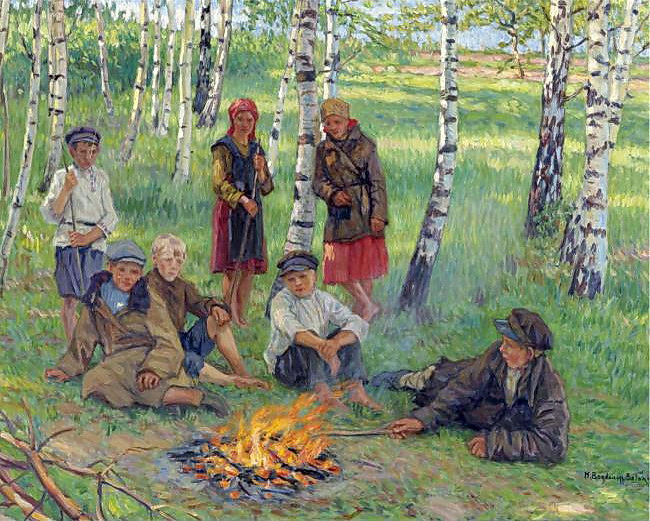 |
|
Progress with mRNA vaccines for infectious diseases
How mRNA is transforming medicine
On Monday, biochemist Katalin Karikó and immunologist Drew Weissman won
the Nobel Prize in Physiology or Medicine for discoveries that enabled
the development of messenger RNA (mRNA) vaccines against COVID-19. And
the field shows no signs of slowing down: mRNA-vaccine developers are
setting their sights on mpox, influenza and cancer.
Synthetic mRNA can be designed and manufactured in days, which allows
vaccines to be reformulated quickly. And the technology could be a game-changer
for pathogens that have eluded vaccine makers, such as cytomegalovirus,
which causes birth defects.
See nature.com
The tangled history of mRNA vaccines, by Elie Dolgin, 14 September
2021
Hundreds of scientists had worked on mRNA vaccines for decades before
the coronavirus pandemic brought a breakthrough.
Country Boy, par Nikolay Bogdanov-Belsky (1868-1945)
|
08
- 16/10/2023
|
 |
|
Girl / Jeune fille, par Nikolay Bogdanov-Belsky (1868-1945)
|
09
- 16/10/2023
|
 |
|
World Resources Institute, People, Nature and Climate
WRI's mission is to move human society to live in ways that protect Earth’s
environment and its capacity to provide for the needs and aspirations
of current and future generations.
We organize our work around six critical goals that the world must achieve
this decade in order to secure a sustainable future:
Climate: Protect communities and natural ecosystems from damage caused
by greenhouse gas emissions, and generate opportunities for people by
catalyzing a global transition to a low-carbon economy.
Energy: Drive the scale-up of clean, affordable power systems throughout
the world to deliver sustainable socio-economic development.
Food: Ensure the world’s food systems reduce their impact on the environment,
drive economic opportunity, and sustainably feed 9.6 billion people by
2050.
Forests: Alleviate poverty, enhance food security, conserve biodiversity,
and mitigate climate change by reducing forest loss and restoring productivity
to degraded, deforested lands.
Water: Achieve a water-secure future by mapping, measuring, and mitigating
global water risks.
Cities and Transport: Improve quality of life in cities by developing
and scaling environmentally, socially, and economically sustainable urban
and transport solutions.
We design solutions for and analyze these six critical goals through the
lenses of our three Centers of Excellence which focus on Governance, Business
and Finance.
See wri.org
See WRI Water and conflict cartoon
Contact: Ehud GELB
E-mail: ehudgelb(a)gmail.com
Expensive pets
|
21
- 16/10/2023
|
 |
|
France vs USA - 1950 - 2019
|
22
- 16/10/2023
|
 |
|
Next Nasdaq fall?
|
22
- 16/10/2023
|
 |
|
More US students absent from school
|
24
- 16/10/2023
|
 |
|
Talent et
fan, 1906, par Nikolay Bogdanov-Belsky (1868-1945), musées Arkhangel'sk
|
10
- 16/10/2023
|
 |
|
L’adieu / Farewell, par Nikolay Bogdanov-Belsky (1868-1945)
|
11
- 16/10/2023
|
 |
|
Paysage de Balinovo / Balinovo Landscape, par Nikolay Bogdanov-Belsky
(1868-1945)
|
12
- 16/10/2023
|
 |
|
What Could Go Right? Natural disasters are much less disastrous, by
Emma Varvaloucas
We’re better at dealing with them, and fewer people are dying as a result.
Natural disasters are much less disastrous
Natural disasters are a frequent feature of news coverage. Because the
suffering they cause is highly visual, they are easy to remember: we can
easily recall recent stories on floods, landslides, and wildfires, and
probably even specific photos and videos that were published with them.
Especially now, with climate change such a dominant narrative, our brains
are primed to pay extra attention.
All this naturally leads people into the assumption that we’re worse off
now than we have been in the past when it comes to how deadly natural
disasters are. The opposite is true, however.
Whereas over one million people used to die annually in the early and
mid-1900s from natural disasters, post-2010 that number is 10–20,000.
In 2022 and 2023, however, it was higher, at 60–70,000.
Jeunes campagnards,
par Nikolay Bogdanov-Belsky (1868-1945)
|
13
- 16/10/2023
|
 |
|
Le pêcheur et l’enfant, 1895, par Nikolay Bogdanov-Belsky (1868-1945)
|
14
- 16/10/2023
|
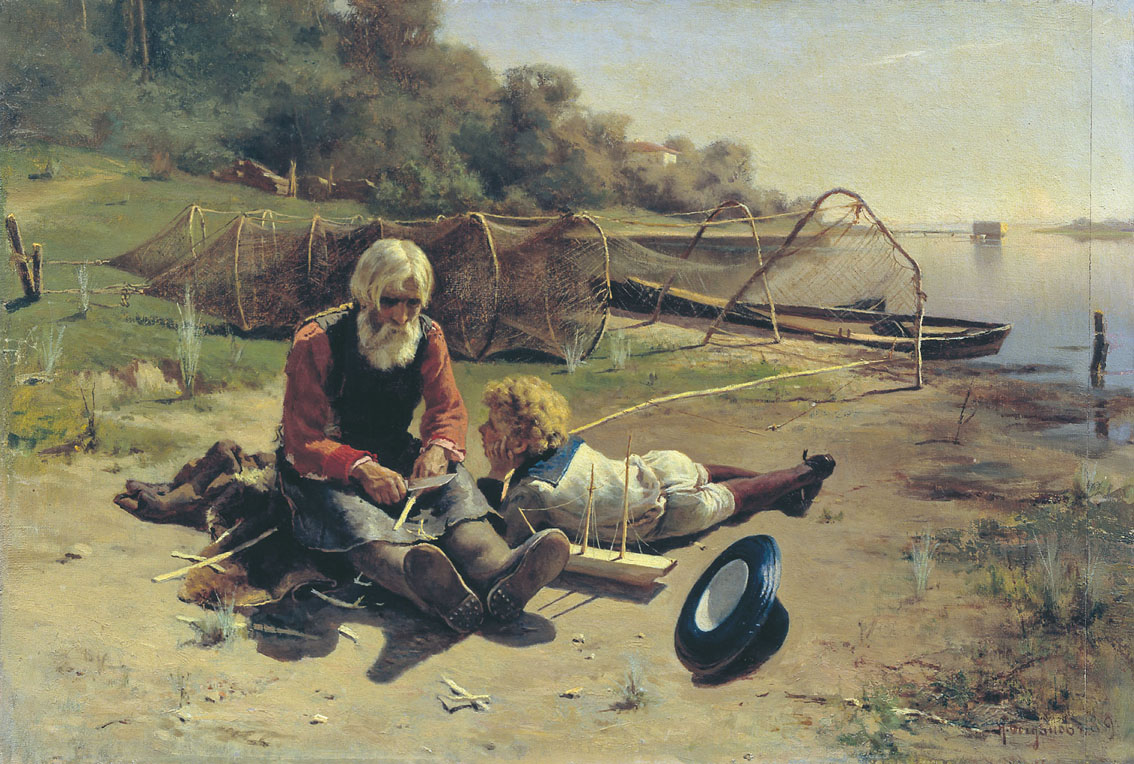 |
|
How much has your country changed since you were born?
I had so much fun with this new tool from Human Progress, where you can
insert a year and a nation and see progress—or regress—on income levels,
infant survival, democratic norms, and more.
See humanprogress.org
Ancient footprints point to early Americans
Fossilized human footprints might be the oldest direct evidence that people
lived in the Americas thousands of years earlier than thought — as early
as 23,000 years ago. Researchers analysed pollen and sediment from the
footprints and found that their ages matched estimates from 2021 that
were based on the ages of seeds stuck in the fossils. The finding supports
the idea that people skirted down the Pacific coast of the Americas after
crossing the Bering land bridge, rather than waiting until ice-age glaciers
retreated from inland routes. The timeline is also supported by indirect
evidence, such as pendants carved from animal remains, but the footprints
in New Mexico are special because they were undoubtedly made by people.
Gene editing makes chickens flu-resistant
Bird-flu-resistant chickens have been created using CRISPR gene editing.
When exposed to the flu virus, nine out of ten of the animals remained
uninfected and didn’t pass the virus to other birds. Researchers modified
a gene encoding a chicken protein that the virus needs to replicate. But
this prompted the virus to start replicating using other proteins in the
same family, which the researchers think could be addressed with more
edits. “We must be careful not to facilitate adaptations of the virus
that make it more dangerous than it [already] is,” says virologist and
study co-author Wendy Barclay.
See english.elpais.com
Chemin forestier, 1933, par Nikolay Bogdanov-Belsky (1868-1945)
|
15
- 16/10/2023
|
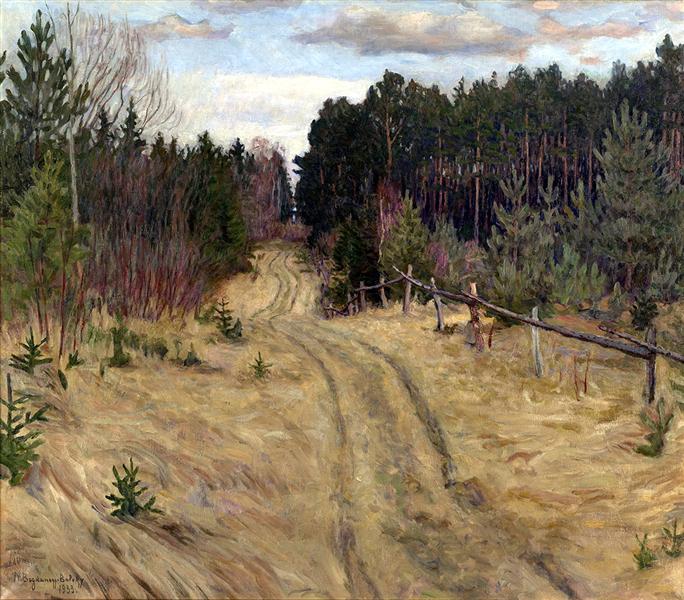 |
|
Enfants dans la tempête, par Nikolay Bogdanov-Belsky (1868-1945)
|
16
- 16/10/2023
|
 |
|
El laboratorio de la oveja ‘Dolly’ crea pollos resistentes a la gripe
aviar con edición genética de Daniel Mediavilla, 10 oct 2023
Se trata de una prueba de concepto que aún se debe perfeccionar para
conseguir una protección total y enfrentarse a los retos de su aplicación
práctica
En el Instituto Roslin de la Universidad de Edimburgo, el centro de investigación
animal donde se creó la oveja Dolly, han utilizado la edición genética
para gestar pollos resistentes a la infección por gripe aviar. Este virus
letal para las aves, que produce grandes pérdidas económicas en todo el
mundo y puede, en algunos casos, infectar a los humanos y matarlos, se
ha mostrado escurridizo para las vacunas, cambiando con rapidez las proteínas
de su superficie que reconoce el sistema inmune. Un grupo de investigadores
británicos, que hoy publica sus resultados en la revista Nature Communications,
ha probado el potencial de modificar pequeñas secciones del ADN de los
pollos para evitar, aunque solo en parte, la infección de gripe.
…/…
Ver elpais.com
How AI might transform the scientific paper
Large language models (LLMs), such as ChatGPT, could become regular assistants
for writing manuscripts, peer-review reports and grant applications.
These artificial-intelligence (AI) tools could change how scientists interrogate
and summarize results, producing ‘papers on demand’ from experimental
data and vastly expanding the scope of meta-analyses and reviews.
But publishers worry that LLMs’ propensity to make up information might
lead to a flood of error-strewn manuscripts — and possibly AI-assisted
fakes. And because LLMs trawl Internet content without concern for bias,
consent or copyright, their use is “automated plagiarism by design”, suggests
cognitive scientist Iris van Rooij.
See nature.com
New fairy tale, 1891, by Nikolay Bogdanov-Belsky, Belarusian National
Arts Museum
|
17
- 16/10/2023
|
 |
|
Girl Reading in a Meadow, 1939, by Nikolay Bogdanov-Belsky, Belarusian
National Arts Museum
|
18
- 16/10/2023
|
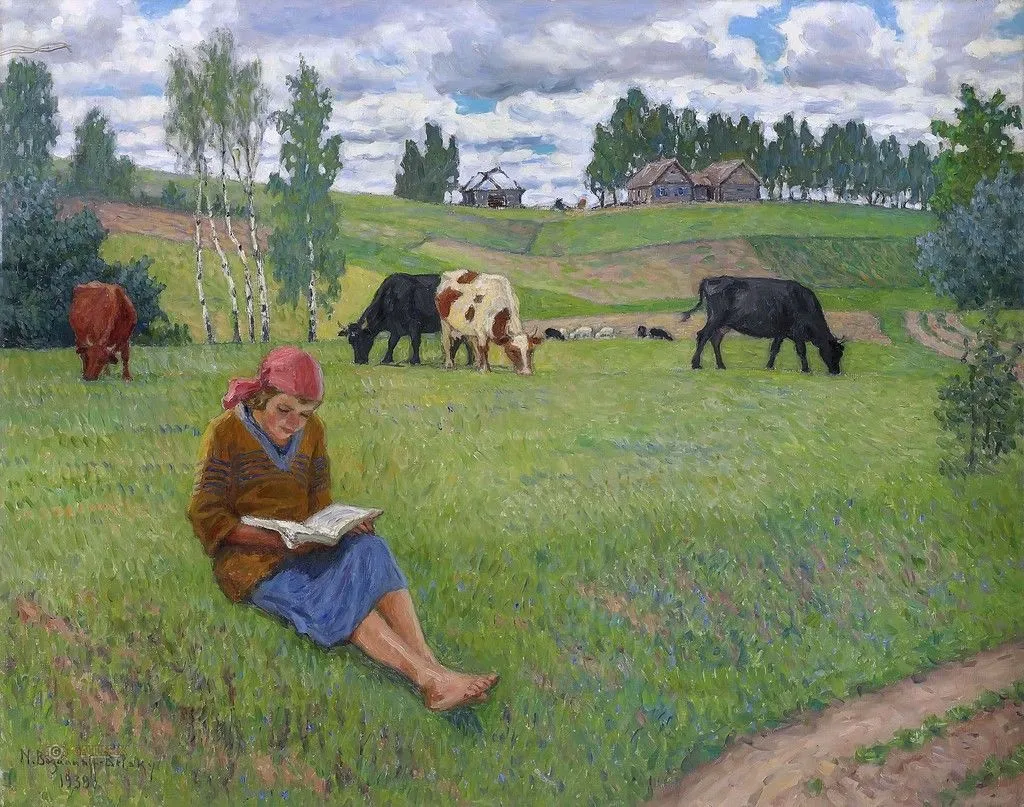 |
|
The best thing that could ever CAP-pen, by Gerardo Fortuna
Forget prophecies of empty coffers and huge cuts for founding members:
Ukraine’s EU accession is the best thing that could ever happen to the
Common Agricultural Policy (CAP).
Is Ukraine’s agriculture too big to be subsidised with EU funds? This
is a recurring question in the recent EU enlargement debate.
This week, a preparatory document to the Granada summit leaked by the
Financial Times scared many with its calculations of the impact Ukraine’s
possible accession would have on the EU budget.
The paper, drafted by the general secretariat of the EU Council, assessed
that Ukraine would be eligible for a whopping €96.5 billion of CAP funds,
leading to cuts of about 20% in farm subsidies to current EU member states.
Ukrainian officials soon replied, saying that evaluating the impact of
Ukraine’s accession on the EU’s farming subsidies under the current criteria
is not a relevant exercise, since Kyiv’s EU membership will likely lead
to the end of the Common Agricultural Policy (CAP) as we know it today.
Having been an agri-food reporter for a long time, I’ve heard other people
wonder – actually quite often – how such a global agricultural powerhouse
can be integrated into the EU’s farming subsidies programme without going
bankrupt.
I’ll be going against the trend and saying that an eventual Ukraine’s
EU accession (which now seems much closer than ever before) will even
have a beneficial impact on our beloved CAP – or at least on two of its
long-standing controversial aspects.
First, one of the most feared things by European farmers at the beginning
of any CAP talks: cuts to EU subsidies.
The CAP financial envelope was already heavily downsized in the multi-annual
financial framework (MFF) for the 2021-2027 period due to Brexit, with
a huge loss of funds particularly in the rural development aid (for the
insiders: the so-called second pillar).
Ahead of the talks on the next seven-year programming period, there’s
also a widespread sentiment that devolving almost one-third of the EU
budget to farming might, perhaps, be a bit too much as there is a need
to get money for new priorities such as defence or industrial policy.
The other main point is some sort of ‘un-reformability’ of the CAP, which
is still considered a policy that can be tweaked and re-tweaked but eventually
remains equal to itself.
Think about those countries like Italy and the Netherlands – or the then
EU member state the United Kingdom – which have always pushed for giving
more relevance to rural development rather than to the traditional direct
payments to farmers without getting basically nothing in return.
Even the recent attempts to green the CAP with the so-called eco-schemes
have been considered only a drop in the ocean.
But Ukraine’s EU membership could be a game-changer for both aspects.
Since integrating Ukraine into the CAP is a huge challenge (but an essential
one), it won’t be possible without proper financial resources – meaning
the Commission and the EU lawmakers might think twice before suggesting
cuts in the CAP.
Likewise, you can’t face this challenge without a proper farm reform aimed
at a re-thinking of the direct payment per hectare system (for the insiders:
the so-called first pillar), since the average size of arable land of
Ukrainian farm enterprises amounts to 485 hectares (in France, for instance,
is 30 hectares; in Poland is eight hectares).
This means that the setting up of a badly needed redistributive payment
scheme capping direct payments to large farms will become a priority.
Of course, there are also food safety issues for Ukraine products to sort
out, as well as some risks that might arise with the CAP implementation
because of the level of corruption in the neighbouring country.
CAP reform talks will be kicked off in the next mandate, and come into
effect only in the 2028-2035 programming period.
Even the most optimistic about it wouldn’t think that Ukraine will join
the EU before 2035. Still, Ukraine will be the elephant in the negotiating
room and probably the leading force to avoid cuts and impose a real CAP
reform.
It’s not bad at all, is it?
See euractiv.eu
AI predicts 70% of earthquakes a week before they occur, by Loukia
Papadopoulos, Oct 07, 2023
The system only flagged eight false warnings and missed one earthquake.
See interestingengineering.com
"Bad" Joke
A Priest and a Rabbi go for a Walk in the Park
As both come by a beautiful lake, the rabbi says: “Let’s take a dip,
the water looks refreshing!”
“But we have no trunks”.
“Then let’s go in as god has created us.”
Said and done, they go in. After a while, they get out and walk back
to their clothes. There, a small group of people surprise the two
naked men.
Full of shame, the priest covers his manhood. He looks to the right
and sees the rabbi covering his face.
“What are you doing?”, he asks.
The rabbi answers: “My people recognize me by my face.”
The creation of this efita newsletter is sponsored by Acta Digital
Services and its distribution by vitisphere.com
Please, contribute to the content of your efita newsletter, and advertise
your events, new publications, new products and new project in this
newsletter. Without your support, it will not survive!
Contact: Guy WAKSMAN
E-mail: guy.waksman(a)laposte.net
To read this newsletter on our web site
See Efita
The archives of this newsletter
See Efita
About the EFITA mailing list
You can use the efita moderated list (> 15000 subscribers) to announce
any event / product / web site / joke (!) related to IT in agriculture,
environment, food industry and rural areas.
If you want to subscribe a friend, please fill in his
form.
If you do not wish to receive our messages, please fill in the following
form...
|









